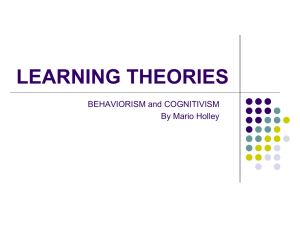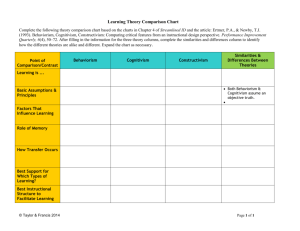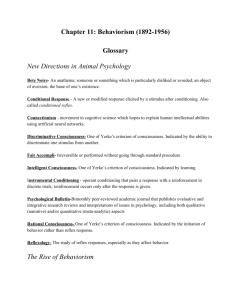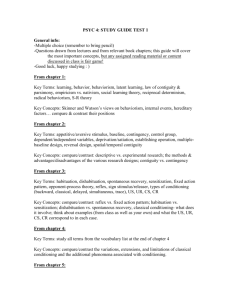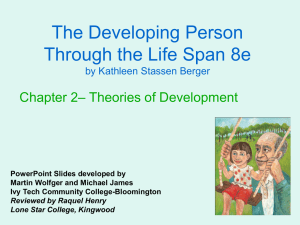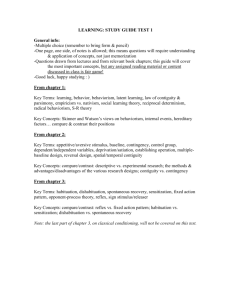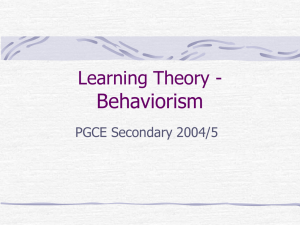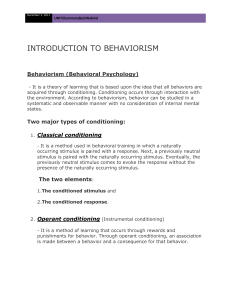Intro to course and What is learning?
advertisement
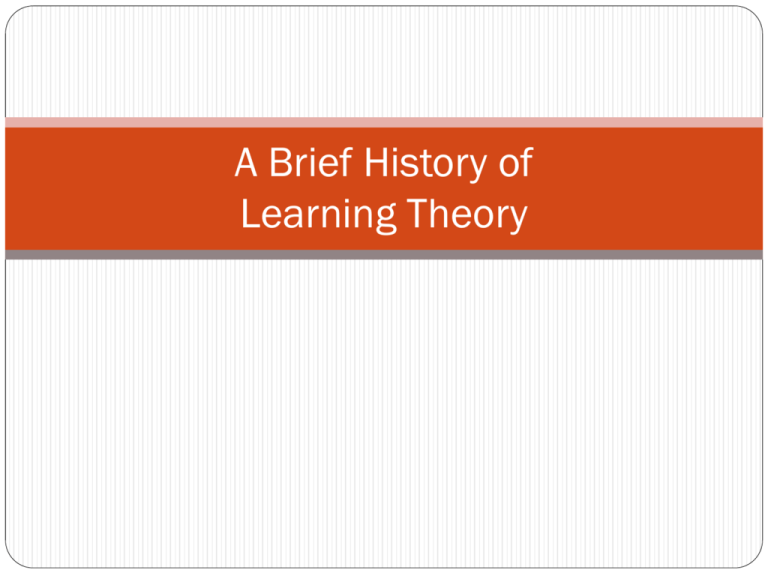
A Brief History of Learning Theory How do we evaluate theories? Testability (Falsifiability) theory should make unambiguous predictions that can be tested against the facts. Falsifiability: a good theory is one that, in principle, can be proven wrong is a poor theory if is untestable, or unfalsifiable Simplicity or Parsimony: given two theories that are equal in testability, one that uses fewer hypothetical constructs and assumptions is the preferred theory Generality: theories that deal w/more phenomena with a greater range of oservations are usually judged to better than those w/less Fruitfulness: theories that stimulate further research and further thinking about a particular topic are usually judged to be better Agreement w/data: theories that are supported by data (obviously) are better theories Learning theory depends upon: Epistemology: Branch of philosophy that deals with nature of knowledge The study of knowledge Asking and examining answers to several critical questions: What is knowledge? What can we know? What are limits of knowledge? What does it mean to know? What are origins of knowledge? How has this been accomplished across the history of academics? Why do we care? What does it tell us about today’s research approaches? Early history of learning theory Plato: Nativism: Knowledge is inherited and a natural component of the human mind Every object in physical world has corresponding abstract idea or form that causes it We experience a “tree” but not “treeness” Rationalism: One gains knowledge by reflecting on the contents of one’s mind: The mind’s eye Turn inward to ponder what is innately available Believes in a soul Reminiscence: recollection of our experience that our soul had in heaven which is beyond heaven Plato’s Cave analogy Early history of Learning Theory Aristotle: Empiricism: Knowledge derived from sensory experiences; was NOT inherited Rationalism: mind is actively involved in attainment of knowledge Nativism: Mind must actively ponder the information provided by the senses to discover the knowledge contained within the information Described in detail the human senses Laws of association: experience or recall of one object will elicit recall of things Similar to that object (similarity) Opposite that object (contrast) That were once originally experienced with that object (contiguity) Early History of Learning Theories DesCartes Knowledge is innate Mind versus body problem Separate laws govern each Only humans have souls (mind) Body has “animal spirits” Two do influence one another Reflex arc: Why important? Showed mechanisms of body Early History of Learning Theories The British Empiricist include: Thomas Hobbes (1651) John Locke (1690) James Mill (1829) John Stuart Mill (1843) Source of all knowledge was sensory experience people born knowing nothing gradually gather knowledge via experience Tabula rasa or blank slate idea (Locke) opposite of Kant's Nativism extreme position = Empiricist position Set hypotheses for Associationism: Outlined how old concepts become associated in memory how new concepts are formed Hypothesized a direct correspondence between experience and memory one-to-one correspondence between simple sensations and simple ideas experience = sensations memory = ideas idea = form of a sensation Complex ideas: James Mill two or more simple sensations repeatedly presented together, product of union may be complex idea once complex idea formed, can also be evoked by process of association from simple sensations or ideas Set hypotheses for Associationism: Thomas Brown (1982): Secondary Principles of association: attempt to make Mills theory more complete Several hypotheses The length of time 2 sentences coexist determines the strength of association The liveliness or vividness of sensations also affects strength of association The frequency of pairings: more frequent = stronger association Recency of pairings: more recent = stronger association Freedom from other strong associations Constitutional differences current emotional states momentary state of body individual prior habits Variations on Associationism George Berkely: we can experience only secondary qualities Nothing exists unless it ispercevied To be is to be perceived David Hume: We know nothing for sure about ideas We can be sure of nothing Mind = stream of ideas, memories, imaginings, associations, feelings We experience empirical world only indirectly through our own ideas “Habitual order of ideas” give rise to general concepts like causation Immanual Kant (1724-1804): Innate categories of thought: Careful analysis of our experiences reveals certain categories of thought Categories included: Causality, unity, totality, reality, existence, necessity, reciprocity, (and 5 more) Mental faculties superimposed over our sensory experiences, providing them with structure and meaning John Stuart Mill: Complex associations Most important contribution: The whole is different from the sum of its parts (Wait, didn’t the Gestaltists say this!?!!?) Historical influences Thomas Reid: Naïve Realism What we perceive = naïve realism Mind has powers of its own which strongly influence how we perceive world Faculty of psychology: mixture of nativism, rationalism, empiricism Franz Joseph Gall Faculties housed in specific brain locations Phrenology: two lasting effects Led to emerging neuroscience research Belief that faculties become stronger with practice- the mental muscle Other Historical influences Charles Darwin (1809-1882): Biological evolution 1859 book: Origin of Species argued species originated from other species and eventually become distinct from their ancestors thus: many animals have common, but very distant, ancestors Evidence from domesticated plants and animals breeding programs; hybrid plants, purebred dogs, cats, etc. Great similarity in body parts across animals: paws, arms, etc. embryology: most embryos look HIGHLY similar Fossil records: Natural Selection: Darwin’s 5 major premises: the members of particular species have characteristics that vary some of these variable characteristics are passed on from parents to siblings some of these variable characteristics aid survival species produce more offspring than survive to become adults those characteristics that aid survival will become more common across generations, those that impede survival will die out. Early influences on Learning Theory Hermann Ebbinghaus (1850-1909) First empirical test of associationist hypotheses used nonsense syllables to avoid prior associations served as own subject measured length of time took to learn, amount remembered after some passage of time Results: Several major findings List length: the greater the list- the greater the time to learn PER item Effects of repetition: over-learning and mastery Effects of time on remembering and forgetting: discovered forgetting curve serial position curve Role of contiguity: more contiguity = greater learning Backwards associations Provided DATA for associationist principles Ivan Pavlov 1849-1936 Pavlov’s Contribution Ivan Pavlov Son of a Russian Orthodox priest Russian physiologist: Studied salivation 1901: discovered and wrote about classical conditioning Found that his dogs reacted to both his presence and the time of day for feeding/experimentation Wanted a way to study conditioned reflexes systematically Researched this: Measured amount of salivation during baseline: Present food to dogs Measure slobber Then added a predictive stimulus: a Bell Presented the BellFood Measured slobber to see if dogs would begin to slobber to the bell Classical Conditioning Remember the Reflex Arc Reflex is elicited by a stimulus Classical conditoning is learning to react to a predictive stimulus The predictive stimulus predicts the eliciting stimulus The eliciting stimulus elicits the reflex Learn to anticipate the reflex behavior so that it occurs to the predictive stimulus Classical Conditioning Procedure CS US UR Bell Food CR Slobber with less Digestive enzymes Slobber Behaviorism Watson (1878-1958) founded the school of psychology known as behaviorism. Psychology should be a science of behavior only. Believed that environment molds behavior By 1920s, behaviorism became dominant force in American psychology B.F. Skinner Studied how behavior is shaped by rewards and punishments Principles of learning apply to animals and humans alike Thordike(s) and Guthrie also had profound effects on learning/education John B. Watson (1878-1958) Also studied conditioned reflex University of Chicago PhD. With John Dewey, who’s ideas he rejected STRICT behaviorism: Everything is learned, no affect from biology Started out as an educator; developed his theory of behaviorism Felt that any research should use ONLY observable events: rejecting structualism and gestalt schools Rejected traditional study of “thoughts” and “feelings” Had access to Pavlov’s work (unlike E.L. Thorndike) But felt that this Classical Conditioning could be used in other ways Most famous work: Little Albert Study Demonstrated classical conditioning of the emotion of fear But: got in hot water: Behavioral “eugenics”: believed if he could control environmental variables, could control outcome of any human Had an affair with his grad student Ethics of Little Albert study E.L. Thorndike 1874-1949 Thorndike: began to look at Instrumental Behavior Son of a Methodist Minister Graduate of Harvard, student of and highly influenced by William James Professor at Columbia University, influential in starting the psych program there Animal Intelligence (1911) Rated the intelligence of various animals One of the first contemporary psychologists to examine how animals learned Focus on trial and error learning Did NOT have access to Pavlov’s work. Experimented with cats in a puzzle box Put cats in the box Cats had to figure out how to pull/push/move lever to get out; when out got reward The cats got faster and faster with each trial Law of Effect emerged from this research: When a response is followed by a satisfying state of affairs, that response will increase in frequency. When a response is followed by a non-satisfying state of affairs, that response will decrease in frequency Burris Frederick Skinner 1904-1990 Skinner’s influence on modern Behaviorism Skinner studied at Harvard Started out as English major, but was unsuccessful Taught at Minnesota and Indiana University; founded a true Psych department at Indiana just after Harvard started theirs Lifelong friend of Fred Simmons Keller Keller was developing concepts of operant conditioning at Harvard with more of an applied/educational focus Also Nate Schoenfield at Columbia Formed the first “group” of behaviorists Behavior of Organisms (1948) Laid out tenants of his operant or instrumental conditioning Focus on contingencies and consequences Again, avoided non-observable events but did not say they didn’t exist, just that they needed to be operationalized as observable to be studied For more information see his books On Verbal Behavior or Beyond Freedom and Dignity Utopian society:Walden Two (1948) Rise of Behaviorism as a field of study As popularity of research grew, several specialized journals popped up: Journal of The Experimental Analysis of Behavior (JEAB): 1958 Journal of Applied Behavior Analysis (JABA): 1968 Verbal Behavior The Behavior Analyst Division 25 in APA is called Experimental Analysis of Behavior International Association of Behavior Analysis: late 1970’s Several international conferences each year General conference Autism Verbal Behavior Several specialized experimental conferences National conferences in variety of countries Assumptions of Modern Behaviorism Focus on classical and operant behavior; highly influenced by neuroscience Include internal events as part of an organism’s environment Both external AND internal environments influence behavior But: avoid use intervening variables like cognitivists Instead of saying “memory” study relationship between items recalled and length of time between presentation of stimulus and behavior. Feelings and behavior: Don’t consider feelings as “cause” of behavior, but rather as a behavior in and of themselves. Feelings are REAL behaviors that can be studied Again, look for environmental events that may be causal (internal and external) But: also remember that self reported “feelings” can be unreliable: What you think you feel and why you feel it may causal!’ Thinking = behavior Thinking and talking are BEHAVIORS Language = verbal behavior Thinking = private behavior Assume same rules that govern other behaviors will govern thoughts and feelings Obviously, verbal behavior is MUCH more complex in humans but can be studied in similar ways as any behavior Behaviorism Today Not Skinner’s behaviorism! Focus on both theoretical and applied areas EAB: focus on developing theories of behavior How do animals learn about contingencies How do animals categorize/organize stimuli How do animals make decisions ABA: focus on application Biggest impact on autism, developmental disabilities Also in education, business, industry Emerging as major force in animal behavior, particularly with domestic and companion animals

